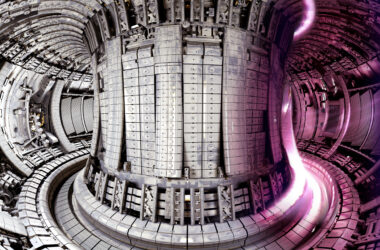
What if we could generate electricity from the very ground beneath our feet? Thanks to researchers at the University of Bath, we may be able to do just that.
Using a low-cost, sustainable technology called soil microbial fuel cells (SMFCs), these scientists are tapping into the power of microorganisms in the soil to generate electricity. From purifying water to decontaminating soil, SMFCs have the potential to revolutionize the way we approach renewable energy.

Bath researchers Jakub Dziegielowski, Dr Jannis Wenk and Dr Mirella Di Lorenzo testing Soil Microbial Fuel Cells in Brazil
The use of renewable energy has become increasingly important in today’s world due to the impact of fossil fuels on the environment. While there are already established renewable technologies such as solar panels and wind turbines, the development of new technologies that harness the power of natural resources is crucial to reduce our reliance on non-renewable energy sources.
What are SMFCs (Soil Microbial Fuel Cells)?
SMFCs use the microorganisms present in the soil to generate electricity.

According to Mirella Di Lorenzo, a professor of biochemical engineering at the University of Bath, microorganisms generate electrons as they break down organic matter in the soil. “All we do is capture those electrons so we can make electricity out of them,” she said when speaking to the BBC.
The proof-of-concept design was demonstrated during field testing in North-East Brazil that took place in 2019 and showed that SMFCs can purify about three litres of water per day- enough to cover a person’s daily water needs.
The Advantages of SMFCs
The advantage of SMFCs is that they generate low-cost, reliable energy and do not rely on difficult-to-source or unsustainable materials. Furthermore, the technology is cheap to set up and requires very little maintenance once operational.
Unlike other established renewable technologies, SMFCs do not contribute to the growing problem of e-waste.
The system consists of two carbon-based electrodes positioned at a fixed distance apart (4cm) and connected to an external circuit. One electrode, the anode, is buried inside the soil, while the other, the cathode, is exposed to air on the soil surface.
Electrigens populate the surface of the anode and as they ‘consume’ the organic compounds present in soil, they generate electrons. These electrons are transferred to the anode and travel to the cathode via the external circuit, generating electricity.
SMFCs: A Solution to Water Scarcity
In 2019, the University of Bath team conducted a pilot in a semi-arid fishing village in the north east of Brazil which is reliant on water stored from the rainy season for use throughout the rest of the year.
The community usually uses chloride to disinfect the water, which can cause health problems such as vomiting and diarrhea when consumed in large amounts. SMFCs have proven to be capable of creating energy to filter a person’s daily drinking water in the Brazilian test.
Water can be made safe using an electrochemical reactor that generates oxidants to purify the water through the application of a current, but this can be problematic for remote communities because it requires a reliable source of energy.
The University of Bath team has successfully powered the reactor through a stack of SMFCs, and their latest version of the technology is able to purify enough water per day to meet the needs of a family of five.
SMFCs: A Solution to Decontamination
The University of Bath team has also received funding from the European Commission for a project to use SMFC technology to decontaminate fossil fuel pollutants in soil.
The principle is that hydrocarbons are digested by the organisms in the soil into less or totally non-harmful components and in doing so they release electrons. “Once again we generate electricity with that and in this way we achieve two things – we purify contaminated soil and you generate electricity at the same time,” explains Prof Di Lorenzo. It could prove transformative for places like the Niger Delta in southern Nigeria, which repeated oil spills.
SMFCs are a promising new renewable energy technology that has many potential applications. From purifying water to decontaminating soil, SMFCs are a sustainable, low-cost solution to some of the world’s biggest environmental problems.
Read the paper Development of a functional stack of soil microbial fuel cells to power a water treatment reactor: From the lab to field trials in North East Brazil in Applied Energy Volume 278
TLDR
- The University of Bath is researching a low-cost and sustainable technology called soil microbial fuel cells (SMFCs) to generate electricity from microorganisms in soil.
- SMFCs can purify water and decontaminate soil, and generate low-cost and reliable energy.
- Unlike other renewable technologies, SMFCs do not contribute to e-waste and require little maintenance once operational.
- SMFCs can filter a person’s daily drinking water in areas that lack a reliable source of energy, like remote communities.
- SMFC technology can also decontaminate fossil fuel pollutants in soil, which could be transformative for places like the Niger Delta in southern Nigeria.
- SMFCs have many potential applications in sustainable energy and can help phase out fossil fuels in combination with other renewable technologies.
- Researchers have demonstrated the proof-of-concept design in North-East Brazil, with more information available in the paper “Development of a functional stack of soil microbial fuel cells to power a water treatment reactor: From the lab to field trials in North East Brazil” in the journal Applied Energy Volume 278.








